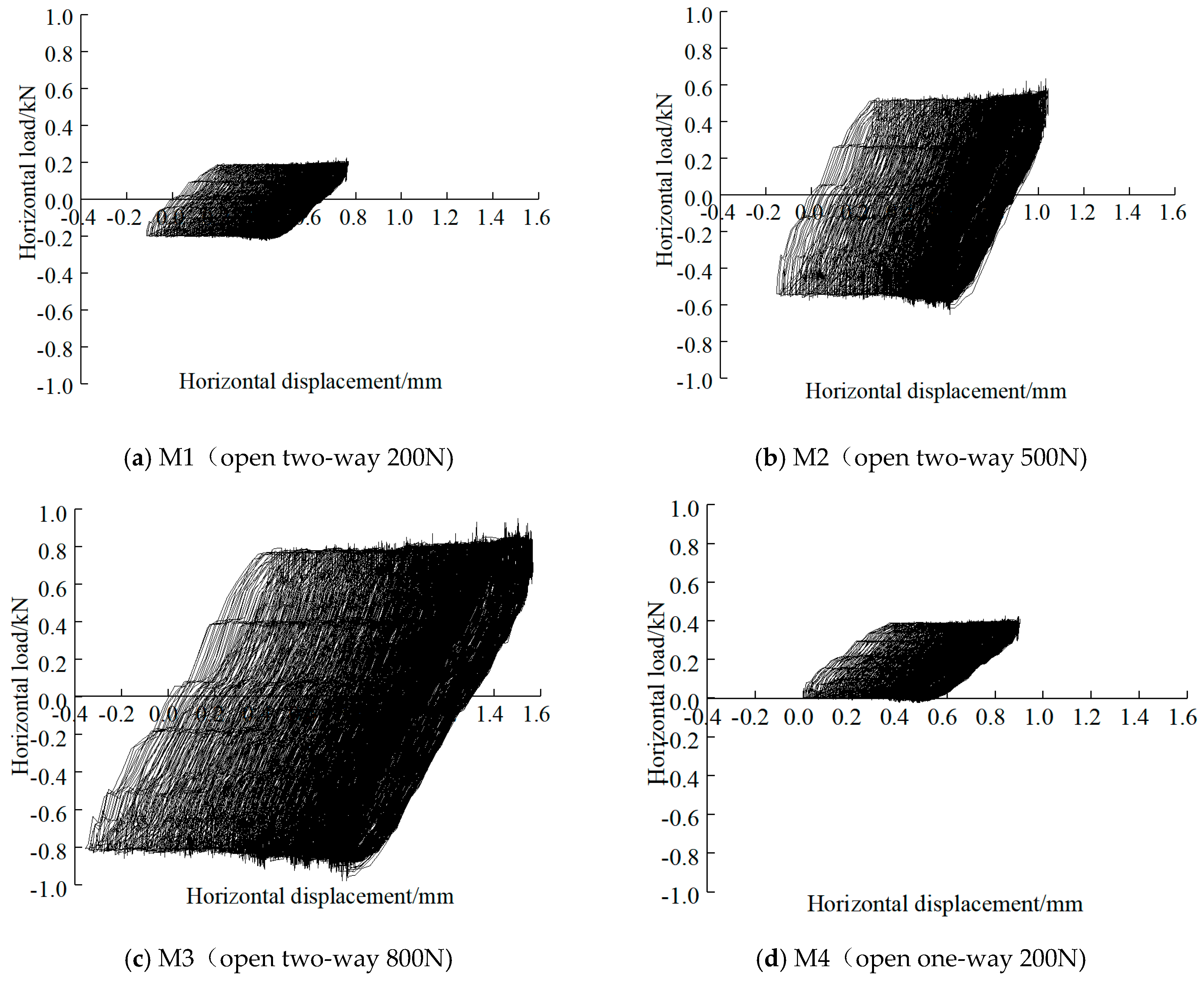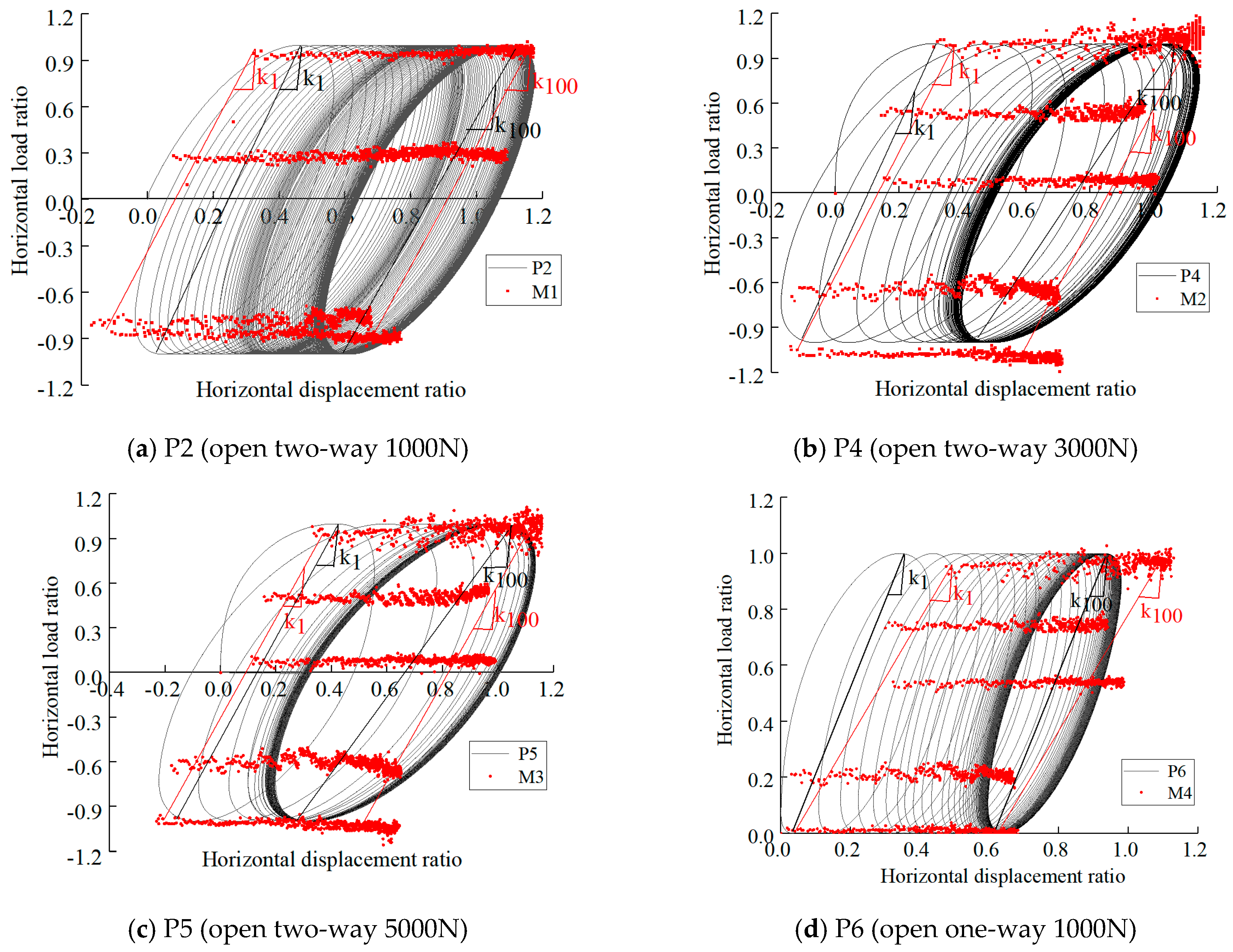Dynamic Response of Offshore Open-Ended Pile under Lateral Cyclic Loadings
Abstract
:1. Introduction
2. Model Test Design
2.1. Model Box and Soil Sample Preparations
2.2. Model Pile and Sensor Layout
2.3. Test Programme
3. Discrete Element Simulations
3.1. Soil Sample Preparation
3.2. Numerical Simulation Model
3.3. Numerical Simulation Programme
4. Test Results and Discussions
4.1. Measured Pile Top Cumulative Displacement under Lateral Cyclic Loadings
4.2. Measured Load-displacement Curve under Lateral Cycling Load
4.3. Measured Surface Displacement under Lateral Cyclic Loading
4.4. Measured Pile Friction under Lateral Cyclic Loading
4.5. Measured Lateral Pressure of Pile under Lateral Cycling Load
4.6. Measured Static p-y Curve under Lateral Cyclic Loadings
5. Numerical Simulation Results
5.1. Computed Cumulative Displacement of Pile Top
5.2. Computed Load-displacement Curves
5.3. Computed Displacement Around Soil
5.4. Computed Pile Side Friction
5.5. Computed Lateral Pressure of the Pile Body
6. Conclusions
Author Contributions
Funding
Conflicts of Interest
References
- Matlock, H. Correlations for design of laterally loaded piles in soft clay. In Proceedings of the 2nd Offshore Technology Conference, Houston, TX, USA, 22–24 April 1970; pp. 577–594. [Google Scholar] [CrossRef]
- Reese, L.C.; Welch, R.C. Lateral loading of deep foundations in stiff clay. J. Geotech. Geoenviron. Eng. 1975, 101, 633–649. [Google Scholar]
- Reese, L.C.; Cox, W.R.; Koop, F.D. Analysis of laterally loaded piles in sand. In Proceedings of the Offshore Technology Conference; University of Houston: Houston, TX, USA, 1974; pp. 95–105. [Google Scholar] [CrossRef]
- O’Neill, M.W.; Murchison, J.M. An Evaluation of p-y Relationships in Sands; University of Houston: Houston, TX, USA, 1983. [Google Scholar]
- Murchinson, J.M.; O’Neill, M.W. Evaluation of p-y relationships in cohesionless soils. In Proceedings of the Analysis and Design of Pile Foundations, San Francisco, CA, USA, 1–5 October 1984; pp. 174–191. [Google Scholar]
- Georgiadis, M.; Anagnostopoulos, C.; Saflekou, S. Centrifugal testing of laterally loaded piles in sand. Can. Geotech. J. 1992, 29, 208–216. [Google Scholar] [CrossRef]
- Li, W.; Igoe, D.; Gavin, K. Evaluation of CPT-based p-y models for laterally loaded piles in siliceous sand. Geotech. Lett. 2014, 4, 110–117. [Google Scholar] [CrossRef]
- Guo, Z.; Jeng, D.S.; Zhao, H.Y.; Guo, W.; Wang, L.Z. Effect of seepage flow on sediment incipient motion around a free spanning pipeline. Coast. Eng. 2019, 143, 50–62. [Google Scholar] [CrossRef]
- Li, K.; Guo, Z.; Wang, L.Z.; Jiang, H.Y. Effect of seepage flow on shields number around a fixed and sagging pipeline. Ocean Eng. 2019, 172, 487–500. [Google Scholar] [CrossRef]
- Achmus, M. Design of axially and laterally loaded piles for the support of offshore wind energy converters. In Proceedings of the Indian Geotechnical Conference GEOtrendz-2010, Mumbai, India, 16–18 December 2010; pp. 92–102. [Google Scholar]
- Jardine, R.; Chow, F.; Overy, R.; Standing, J. ICP Design Methods for Driven Piles in Sands and Clays; Thomas Telford: London, UK, 2005. [Google Scholar]
- Rosquoet, F.; Thorel, L.; Garnier, J. Lateral cyclic loading of sand-installed piles. Soils Found. 2007, 47, 821–832. [Google Scholar] [CrossRef]
- Leblanc, C.; Houlsby, G.T.; Byrne, B.W. Response of stiff piles in sand to long-term cyclic lateral loading. Géotechnique 2010, 60, 79–90. [Google Scholar] [CrossRef]
- Chen, R.P.; Ren, Y.; Chen, Y.M. Experimental investigation on a single stiff pile subjected to long-term axial cyclic loading. Chin. J. Geotech. Eng. 2011, 33, 1926–1933. (In Chinese) [Google Scholar]
- Zhang, Y.; Wang, Z.G.; Zhao, S.Z. Centrifugal tests of single pile’s bearing capacity subjected to bidirectional cyclic lateral loading. J. Water Resour. Archit. Eng. 2014, 12, 27–31. (In Chinese) [Google Scholar]
- Liu, H.J.; Zhang, D.D.; Lv, X.H. A Methodological Study on the Induction of Triploidy Oyster with Different Salinities; Periodical of Ocean University of China: Beijing, China, 2015; Volume 1, pp. 76–82. (In Chinese) [Google Scholar]
- Liang, F.Y.; Qin, C.R.; Chen, S.Q. Model test for dynamic p-y backbone curves of soil-pile interaction under cyclic lateral loading. China Harb. Eng. 2017, 37, 21–26. (In Chinese) [Google Scholar]
- Li, J.Z.; Wang, X.L.; Zhang, H.R. P-Y curve of weakening saturated clay under lateral cyclic load. China Offshore Platf. 2017, 32, 36–42. (In Chinese) [Google Scholar]
- Brown, D.A.; Reese, L.C.; O’Neill, M.W. Cyclic lateral loading of a large-scale pile group. J. Geotech. Eng. 1987, 113, 1326–1343. [Google Scholar] [CrossRef]
- Little, R.L.; Briaud, J.L. Full Scale Cyclic Lateral Load Tests on Six Single Piles in Sand; No. TAMU-RR-5640; Texas A and M University College Station Department of Civil Engineering: College Station, TX, USA, 1988. [Google Scholar]
- Brown, D.A.; Reese, L.C. Behavior of a Large-Scale Pile Group Subjected to Cyclic Lateral Loading; Texas University at Austin Geotechnical Engineering Center: Austin, TX, USA, 1988. [Google Scholar]
- Van Impe, W.F.; Reese, L.C. Single Piles and Pile Groups under Lateral Loading; CRC Press: London, UK, 2010. [Google Scholar]
- Stacul, S.; Squeglia, N. Analysis Method for Laterally Loaded Pile Groups Using an Advanced Modeling of Reinforced Concrete Sections. Materials 2018, 11, 300. [Google Scholar] [CrossRef] [PubMed]
- Li, Z.; Haigh, S.K.; Bolton, M.D. Centrifuge modelling of mono-pile under cyclic lateral loads. Phys. Model. Geotech. 2010, 2, 965–970. [Google Scholar]
- Kirkwood, P.B.; Haigh, S.K. Centrifuge testing of monopiles subject to cyclic lateral loading. In Proceedings of Physical Modelling in Geotechnics; Taylor and Francis: London, UK, 2014; pp. 827–831. [Google Scholar]
- Paik, K.; Salgado, R.; Lee, J.; Kim, B. Behavior of open-and closed-ended piles driven into sands. J. Geotech. Geoenviron. Eng. 2003, 129, 296–306. [Google Scholar] [CrossRef]
- Bolton, M.D.; Cheng, Y.P. Micro-geomechanics. In Constitutive and Centrifuge Modelling: Two Extremes (SM Springman); CRC Press: Boca Raton, FL, USA, 2001; pp. 59–74. [Google Scholar]
- Cuéllar, P. Pile Foundations for Offshore Wind Turbines: Numerical and Experimental Investigations on the Behaviour under Short-Term and Long-Term Cyclic Loading; University of Technology Berlin: Berlin, Germany, 2011. [Google Scholar]
- Duan, N.; Cheng, Y.P.; Liu, J.W. DEM analysis of pile installation effect: Comparing a bored and a driven pile. Granul. Matter 2018, 20, 36. [Google Scholar] [CrossRef]
- Duan, N. Mechanical Characteristics of Monopile Foundation in Sand for Offshore Wind Turbine; University College London: London, UK, 2016; Available online: http://discovery.ucl.ac.uk/id/eprint/1529635 (accessed on 23 December 2016).
- Xu, G.M.; Zhang, W.M. A study of size effect and boundary effect in centrifugal tests. Chin. J. Geotech. Eng. 1996, 18, 80–85. (In Chinese) [Google Scholar]
- Hettler, A. Verschiebung Starrer und Elastischer Gründungskörper in Sand bei Monotoner und Zyklischer Belastung; Ver”oentlichungen des Institutes für Bodenmechanik und Felsmechanik der Universität Fridericiana in Karlsruhe: Engler-Bunte-Ring, Germany, 1981; Heft 90. [Google Scholar]
- Zhu, B.; Xiong, G.; Liu, J.C. Centrifuge modelling of a large-diameter single pile under lateral loads in sand. Chin. J. Geotech. Eng. 2013, 35, 1807–1815. (In Chinese) [Google Scholar]
- Zhang, C.R.; Yu, J.; Huang, M.S. P-Y curve analyses of rigid short piles subjected to lateral cyclic load in soft clay. Chin. J. Geotech. Eng. 2011, 33, 78–82. (In Chinese) [Google Scholar]
- American Petroleum Institute. Recommended Practice for Planning, Designing and Constructing Fixed Offshore Platforms-Working Stress Design, 21st ed.; American Petroleum Institute: Washington, DC, USA, 2000. [Google Scholar]























| Test Number | Pile Diameter/mm | Pile End | Loading Method | Amplitude/N |
|---|---|---|---|---|
| M1 | 140 | open | two-way | 200 |
| M2 | 140 | open | two-way | 500 |
| M3 | 140 | open | two-way | 800 |
| M4 | 140 | open | one-way | 200 |
| Physical Parameter | Value |
|---|---|
| Sand particle density (kg/m3) | 2650 |
| Pile density (kg/m3) | 66.65 |
| Acceleration of gravity (m/s2) | 9.8 |
| Median grain size of particle, d50 (mm) | 5.85 |
| Model pile diameter dpile (mm) | 45 |
| Model pile length (mm) | 500 |
| Model pile wall thickness dpw (mm) | 2.475 |
| Model box width (mm) | 2400 |
| Model box depth D (mm) | 2400 |
| Friction coefficient between particles, μ | 0.5 |
| Young’s modulus of particles, Ep (Pa) | 4 × 107 |
| Contact normal stiffness of particles, kn(N/m) | 8 × 107 |
| contact shear stiffness of particles, ks (N/m) | 2 × 107 |
| particle stiffness ratio (ks/kn) | 0.25 |
| Wall normal contact stiffness, kn (N/m) | 6 × 1012 |
| Initial average porosity | 0.25 |
| Final average porosity (Ultimate balance) | 0.185 |
| Test Number | Pile Diameter /mm | Buried Depth/m | Loading Method | Amplitude /N | Frequency /Hz | Cycle |
|---|---|---|---|---|---|---|
| P2 | 45 | 0.4 | two-way | 1000 | 40 | 100 |
| P4 | 45 | 0.4 | two-way | 3000 | 40 | 100 |
| P5 | 45 | 0.4 | two-way | 5000 | 40 | 100 |
| P6 | 45 | 0.4 | one-way | 1000 | 40 | 100 |
© 2019 by the authors. Licensee MDPI, Basel, Switzerland. This article is an open access article distributed under the terms and conditions of the Creative Commons Attribution (CC BY) license (http://creativecommons.org/licenses/by/4.0/).
Share and Cite
Liu, J.; Guo, Z.; Zhu, N.; Zhao, H.; Garg, A.; Xu, L.; Liu, T.; Fu, C. Dynamic Response of Offshore Open-Ended Pile under Lateral Cyclic Loadings. J. Mar. Sci. Eng. 2019, 7, 128. https://doi.org/10.3390/jmse7050128
Liu J, Guo Z, Zhu N, Zhao H, Garg A, Xu L, Liu T, Fu C. Dynamic Response of Offshore Open-Ended Pile under Lateral Cyclic Loadings. Journal of Marine Science and Engineering. 2019; 7(5):128. https://doi.org/10.3390/jmse7050128
Chicago/Turabian StyleLiu, Junwei, Zhen Guo, Na Zhu, Hui Zhao, Ankit Garg, Longfei Xu, Tao Liu, and Changchun Fu. 2019. "Dynamic Response of Offshore Open-Ended Pile under Lateral Cyclic Loadings" Journal of Marine Science and Engineering 7, no. 5: 128. https://doi.org/10.3390/jmse7050128




